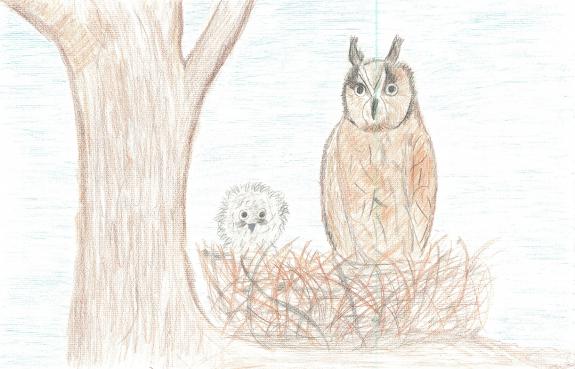Anna Kilpatrick, J. Mason Tomlin Elementary School
Gloucester County
 First Place, Gloucester County, Long-eared Owl (c) Anna Kilpatrick
First Place, Gloucester County, Long-eared Owl (c) Anna Kilpatrick
Long-Eared Owl
Hi, my name is Leah. I’m a Long-Eared Owl and a very busy one. If you have a few minutes, I would like to share some important information about my species Asio otus.
I’m a medium-sized owl about 13.8 to 15.7 inches long with a wingspan of about 35.4 to 39.4 inches. I’d prefer not to tell you my weight, however. I can weigh from 7.8 to 15.3 ounces. I have a white “x” on my face and, of course, my famous feature, ear tufts on the top of my head. I’ll let you know a secret; these aren’t actually ears, just tufts of feathers.
I’m also resourceful. I don’t waste time building a nest when there are many nests left behind by crows, magpies and hawks. I can fit 2 to 10 eggs in a nest, depending on how crowded I want to be. When my new chicks come out of their eggs, they’re covered in white down. We owls don’t waste time. By the time a chick is 5 to 6 weeks old, they begin to fly. They must because when they are 10 to 11 weeks old, we stop feeding them!
My favorite snacks are mice and other small rodents. Sometimes I’m even in the mood for a small bird. My brown, white, and light orange feathers help camouflage me when hunting and help me hide from things that hurt me. Other things I do to protect myself are: adjust my ear tufts and my body to look like a tree. After all, who would want to eat that?
Let me tell you about where I live. Our species must live in dense woods, next to open fields or marshes. Are you thinking we’re picky? That’s not true. The trees and vines provide cover and a place to build our nests, while the open land makes for great hunting. One of the places in NJ where I live is in the Central Passaic Basin. It has dense forests and wetlands, perfect for a long-eared owl. Unfortunately, my home is in danger. With new buildings and roads, my natural habitat is being destroyed. Another problem is pollution.
People used to think of my home as nothing more than a swampy trash can. Even worse, these problems are going on all over. Major habitat loss is the reason we are endangered. It started in the 19th century and we were put on the threatened list in 1991. We are rare in New Jersey, but you can see my fellow long-eared cousins in north central, northwestern and southwestern NJ.
If you’d like to see us more; here’s how you could help: Don’t pollute. Protect our habitats and spread the word by educating your community.
I’d love to stay and chat, but I have to go. If you give a hoot about us, please try to help. I don’t love the idea of being endangered, but it’s better than extinct. Remember, one small thing can make a huge difference!
Written by: Anna Kilpatrick
J. Mason Tomlin Elementary School, Mantua
Teacher: Mrs. Cartwright




